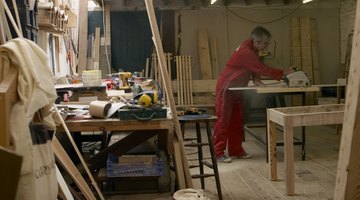What Is Wane in Wood?
Wane is a defect found in lumber. It can refer either to bark or wood missing from the edge of a board. When applied to plywood, wane refers to areas where the veneer is thinner – or missing – which can result from bark in the wood used as the veneer or manufacturing irregularities.

Wane can devalue the selling price of lumber, although for most projects, it usually only affects the appearance, but not the strength or integrity of the wood.
Wood Processing
Sawmills cut logs into boards. Before further processing, most boards exhibit wane, or residual bark or jagged edges where bark was present. Edgers and trimmers then trim wane away, in most cases, although some boards are processed that still have wane. Before sale, lumber cuts are usually examined for quality, and boards with extreme wane are pulled or processed into other wood products.
Wood Grades
Wood is graded, depending on its strength and appearance. Grading, the values of which are set by the United States government and lumber trade associations, is customarily done at the sawmill and affects the price at which the lumber is sold. Factors that determine the wood’s grade include not only the presence of wane, but also knots and twists present in the lumber. Usually, the grade is based on the appearance of the wood, not its overall quality or appropriateness for construction or hobby projects.
Use
Wood with wane is suitable for a wide number of projects, including the building of furnishings, fixtures and interior structures. The only use for which it is inappropriate is as framing lumber in house construction. Because of its irregular edges, boards with wane may not be able to be nailed uniformly, as is required for framing boards.
Detection
Most wane wood is detected by hand, by staff at the sawmill which processed the wood. Depending on the sawmill’s production and staffing levels, wane is often overlooked. Researchers at Virginia Tech are developing software programs that combine image analysis technologies to detect boards with wane that will affect the strength and integrity of the lumber.
References
Writer Bio
A writer and professional lab assistant based in Seattle, Kate Bruscke has been writing professionally about health care and technology since 1998. Her freelance clients include "The Seattle Times," KGB.com, Reading Local: Seattle, Nordstrom and MSN/Microsoft. Bruscke holds a Master of Fine Arts from The School of the Art Institute of Chicago.
Photo Credits
- Michael Blann/Digital Vision/Getty Images
- Michael Blann/Digital Vision/Getty Images
More Articles



